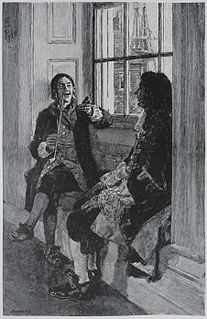Related Research Articles
Robert Culliford was a pirate from Cornwall who is best remembered for repeatedly checking the designs of Captain William Kidd.

Thomas Tew, also known as the Rhode Island Pirate, was a 17th-century English privateer-turned-pirate. He embarked on two major pirate voyages and met a bloody death on the second, and he pioneered the route which became known as the Pirate Round. Many other infamous pirates followed in his path, including Henry Every and William Kidd.
Adam Baldridge was an English pirate and one of the early founders of the pirate settlements in Madagascar.
Dirk Chivers was a Dutch pirate active in the Red Sea and Indian Ocean.
The Pirate Round was a sailing route followed by certain, mainly English, pirates, during the late 17th century and early 18th century. The course led from the western Atlantic, parallel to the Cape Route around the southern tip of Africa, stopping at Madagascar, then on to targets such as the coast of Yemen and India. The Pirate Round was briefly used again during the early 1720s. Pirates who followed the route are sometimes referred to as Roundsmen. The Pirate Round was largely co-extensive with the routes of the East India Company ships, of Britain and other nations.
Abraham Samuel, also known as "Tolinar Rex," born in Martinique, was a mulatto pirate of the Indian Ocean in the days of the Pirate Round in the late-1690s. Being shipwrecked on his way back to New York, he briefly led a combined pirate-Antanosy kingdom from Fort Dauphin, Madagascar, from 1697 until he died there in 1705.
Joseph Faro was a pirate from Newport active during the Golden Age of Piracy, primarily in the Indian Ocean. He is best known for sailing alongside Thomas Tew to join Henry Every’s pirate fleet which captured and looted the fabulously rich Mughal ship Gunsway.
Thomas Wake was a pirate from Newport. Active during the Golden Age of Piracy, he is best known for sailing alongside Thomas Tew to join Henry Every in the Indian Ocean, hunting the Moghul treasure fleet.
John Ireland was a pirate active in the Indian Ocean. He is best known for sailing with Thomas Tew.
Richard Want was a pirate active in the Indian Ocean. He is best known for sailing alongside Thomas Tew and Henry Avery.
John Hoar was a pirate and privateer active in the late 1690s in the Red Sea area.
Robert Colley was an English pirate and privateer active near Newfoundland and the Indian Ocean.
Robert Glover was an Irish-American pirate active in the Red Sea and Indian Ocean area in the late 1690s.
Richard Glover was a pirate and slave-trader active in the Caribbean and the Red Sea in the late 1690s.
Thomas Mostyn was a sea captain and slave trader active between New York and the Indian Ocean, and later in the Caribbean. He was one of the traders employed by New York merchant Frederick Philipse to smuggle supplies to the pirates of Madagascar.
William Mayes was a pirate active in the Indian Ocean. He was best known for taking over William Kidd’s ship Blessed William and sailing with Henry Avery.
Ralph Stout was a pirate active in the Indian Ocean. He is best known for rescuing fellow pirate Robert Culliford after each of them spent separate 4-year periods in Mughal Empire prisons.
Edward Woodman was a pirate active in the Indian Ocean and the Caribbean.
Mathurin Desmarestz was a French pirate and buccaneer active in the Caribbean, the Pacific, and the Indian Ocean.
Thomas Collins was a pirate active in the Indian Ocean. He is best known for leading a pirate settlement and trading post on Madagascar.
References
- 1 2 3 Zacks, Richard (2003). The Pirate Hunter: The True Story of Captain Kidd. New York: Hachette Books. ISBN 9781401398187 . Retrieved 2 June 2017.
- 1 2 Jameson, John Franklin (1923). Privateering and Piracy in the Colonial Period by J. Franklin Jameson. New York: Macmillan. p. 184. Retrieved 2 June 2017.
- 1 2 3 4 5 6 Grey, Charles (1933). PIRATES OF THE EASTERN SEAS (1618-1723). London: PURNELL AND SONS. Retrieved 1 June 2017.
